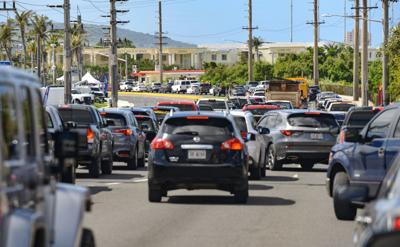While Guam has witnessed fewer hot car deaths or vehicular heatstroke, notably the heartbreaking losses in 2013 and 2022, every one of these deaths could have been prevented, according to the Department of Public Works’ Office of Highway Safety.
Vehicular heatstroke remains a leading cause of non-crash, vehicle-related death for children under 14 in the U.S.
On average, 37 children tragically lose their lives each year due to vehicular heatstroke. In 2023, this included 29 young lives.
DPW’s OHS is leading the observance of May 1 as National Heatstroke Prevention Day.
Drivers need to always check the back seat when walking away from their vehicle, and to call 911 if you see a child alone in a hot car, are among steps one can take to prevent vehicular heatstroke.
In conjunction with the observation of National Heatstroke Prevention Day, DPW’s OHS reminds families and caregivers that “Once you park, stop, look, lock.”
Vehicles heat rapidly, with internal temperatures reaching up to 50 degrees higher than the outside air.
Even on cooler days on Guam, the temperatures inside a parked vehicle can quickly become lethal.
Children’s body temperatures rise much faster than those of adults, making them especially vulnerable.
“Despite it being years since our last fatal incident, the tragedy is that these deaths are entirely preventable,” DPW Director Vince Arriola said. “We must remind everyone that a vehicle is not a play area.”
DPW-OHS urges all parents and caregivers to do these three things to help prevent child heatstroke:
- When getting out of a car, make it a habit to look in the back seat every time.
- Never leave a child in a vehicle unattended, even for one minute.
- Always lock the car and put the keys out of reach.
- For bystanders, if you see a child in a hot vehicle, make sure the child is okay and responsive. If not, call 911 immediately.
- If the child appears okay, attempt to locate the parents or have the facility’s security or management page the car owner over the PA system.
- If there are two people around, one person should actively search for the parent while the other waits at the car.
- If the child is not responsive or appears to be in distress, attempt to get into the car to assist the child, even if that means breaking a window.
The warning signs of heatstroke are a red, hot, and moist or dry skin, no sweating, a strong rapid pulse or a slow weak pulse, nausea, confusion, or acting strangely.
If a child exhibits any of these signs after being in a hot vehicle, quickly spray the child with cool water or with a garden hose. Never put a child in an ice bath. Call 911 or a local emergency number immediately.
For more information on vehicle heatstroke, visit www.nhtsa.gov/campaign/heatstroke, or call the DPW-Office of Highway Safety at (671) 647-4343/3215 or (671) 649-5064.












(0) comments
Welcome to the discussion.
Log In
Keep it Clean. Please avoid obscene, vulgar, lewd, racist or sexually-oriented language.
PLEASE TURN OFF YOUR CAPS LOCK.
Don't Threaten. Threats of harming another person will not be tolerated.
Be Truthful. Don't knowingly lie about anyone or anything.
Be Nice. No racism, sexism or any sort of -ism that is degrading to another person.
Be Proactive. Use the 'Report' link on each comment to let us know of abusive posts.
Share with Us. We'd love to hear eyewitness accounts, the history behind an article.